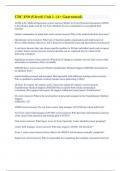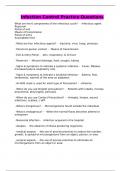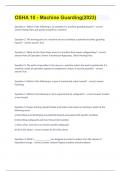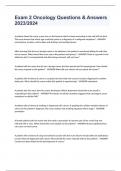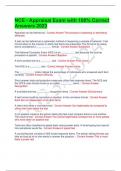-What is personality?
● Unique psychological qualities of an individual that influence a variety of characteristic
behavior patterns across different situations and over time.
-Assessing Personality
● Objective Test ( Ask directly about your personality)
○ MMPI(Minnesota Multiphasic Personality Inventory): consists of true or false
questions intended to measure certain personality dimensions, especially for
identifying clinical conditions. In total it has 550 items the new edition MMPI-2
has 567 items
○ NEO-PI(NEO Personality Inventory-revised): Includes 240 items to measure
neuroticism, extraversion, openness, agreeableness.
○ MBTI( Myers-Briggs Type Indicator): Test of normal personality, loosely on
Carl Jung’s theories. Jung emphasized extraversion( attending to the outside
world) and introversion( concentrating on one’s inner world).
● Projective Test:(
Designed to encourage people to project their personality characteristics
onto ambiguous stimuli)
○ Rorschach: A projective technique based on people’s interpretations of 10
ambiguous inkblots. It was created by Hermann Rorschach
○ TAT(Thematic Appreciation Test): The person is asked to make up a story for
each picture, describing what events led up to this scene, what is happening now,
and what will happen in the future.
-Are there personality traits and if so how many?
● Trait personality theories
○ Allport’s Trait Approach
■ Cardinal/Central Traits
■ Secondary Traits
○ Cattell’s 16 Factors(source trait)
■ ex:Trusting, tense, outgoing, suspicious
○ Eysenck’s 3 dimensions
■ Extraversion(Internal vs External)
■ Neuroticism(Emotionally stable vs Unstable)
■ Psychoticism(kind vs antisocial)
● The ‘Big Five’
*Remember OCEAN
, O-Openness to experience(Creative, intellectual, and open-minded versus simple, shallow,
and unintelligent)
C-Conscientiousness(Organized, responsible, cautious versus careless, frivolous, and
irresponsible)
E-Extraversion (Talkative, energetic, and assertive compared to quiet,reserved, and shy)
A-Agreeableness(Sympathetic, kind, and affectionate compared to cold, quarrelsome, and
cruel)
N-Neuroticism(Anxious, unstable, temperamental versus stable, calm, and contented)
-Applications of Personality
● School, Family,Education and policy
● Susceptibility and resilience
● Therapy
● Legal issue
-Theories
● Psychodynamic
● Humanistic
● Social-Learning and Cognitive********
● Traits
-Freud's: Psychodynamic
● Ego: Directly instinctual drives and urges into appropriate channels
○ Balance needs of ID against demands of the superego, trying to make them fit
best within reality also known as “ Reality principle”
● Superego: Represents society's values , standards, morality
● The Id: Primitive, unconscious part of the personality also known as “Pleasure principle”
-Structure of the personality
● Repression-Motivated removal of something to the unconscious
● Denial- The refusal to believe unpleasant information
● Rationalization- Attempt to show that their actions are justifiable
● Displacement- Diverting a behavior or thought away from its national target toward a
less threatening target
● Regression- A return to a more immature level of functioning
● Project- Attribution one’s own undesirable characteristics to other people
● Reaction Formation- To present themselves as the opposite of what they really are
● Sublimation- The transformation of sexual or aggressive energies into culturally
acceptable, even admirable behaviors
-Humanistic Psychology
● Became popular in the 60’s and 70’s
● Optimistic view of the person


